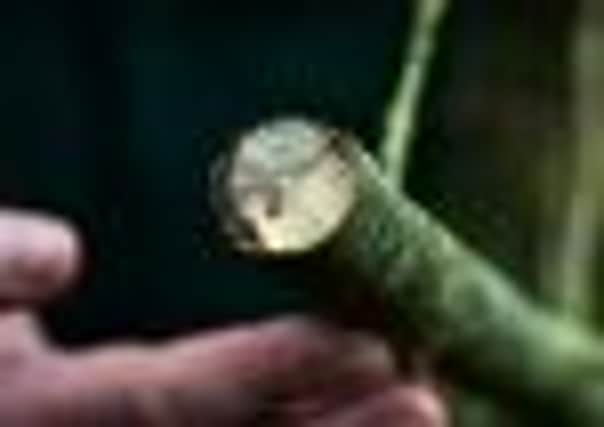Ash dieback cases rise again in Scotland


• Scottish cases of ash dieback on the rise again
• 49 cases now confirmed across country by Forestry Commission Scotland
Latest results from the Forestry Commission Scotland (FCS) revealed nine new cases of ash dieback have been confirmed across Scotland, taking the total to 49 so far.
Advertisement
Hide AdAdvertisement
Hide Ad

Officials warned that numbers may increase further as scientists continue to analyse suspected sites identified last year, although the disease itself is not currently spreading because it is dormant during winter months.
The announcement was made at the latest summit on the outbreak, where the Scottish Government proposed a vast refuge area across the northwest in a bid to reduce the impact of the disease when it becomes active again in the summer.
A sheltered area, stretching north and west from the Mull of Kintyre to Inverness, would be bordered by a buffer zone including the Isle of Bute, Loch Lomond and parts of Grampian west of Elgin.
Ministers are proposing to legally enforce the removal and killing of all recently planted ash trees on any infected sites found within the refuge area and of any new saplings in the buffer zone showing clear signs of infection, caused by the fungus Chalara.


The proposal is based on evidence suggesting that the disease appears to have entered Scotland in the east via infected spores blown over from Scandinavia, where dieback has already wiped out countless trees.
The zone is a key part of the Scottish Government’s draft action plan on tackling tree diseases including dieback.
Environment and Climate Change Minister Paul Wheelhouse chaired the latest summit in Edinburgh yesterday to seek responses from environmental charities and the private forestry sector on tackling the issues.
He said: “Chalara is here to stay but we can put in train measures to lessen its impact and, in the lower risk areas in the remoter north and west, we might also be able to delay the onset of infection by taking targeted action to remove diseased young trees before they start to have a significant, wider affect.”
Advertisement
Hide AdAdvertisement
Hide AdSpeaking afterwards he added: “The northwest already has a high concentration of ash. We hope that this protected area will also help to buy time while we work on creating resistant ash [strains].”
He also warned the public against rogue traders who have been over-charging people in England and giving erroneous advice on felling infected trees in private gardens.
He said: “I have not heard of this happening in Scotland yet but we want to warn people about a ‘White Van Man’ phenomenon in England where people have been charging extortionate amounts to fell ash trees and telling people they need to be cut down urgently when that is not the case. In fact it may be of value to us to observe these mature trees.”
Welcoming the latest summit, Rory Syme of the Woodland Trust Scotland said: “Scotland’s ash trees and the species that depend on the habitat they provide face an uncertain future... We support the actions outlined in the draft Chalara action plan, and will continue to work within the Scottish Tree Health Advisory Group.”
Stuart Goodall, chief executive of private forestry sector group Confor, said: “It is vital that the Scottish Government and the private sector worked together effectively to reduce the impact of tree pests and diseases on Scotland’s woodlands and forests.”
The idea of creating refuge zones to help save Scotland’s woodlands was first suggested last year amidst growing fears about the outbreak.
A UK-wide ban on imports of saplings which could also be a route for the disease if they are infected remains in place.
The nine newly confirmed sites include two near Cumbernauld and one near Bankfoot, north of Perth.